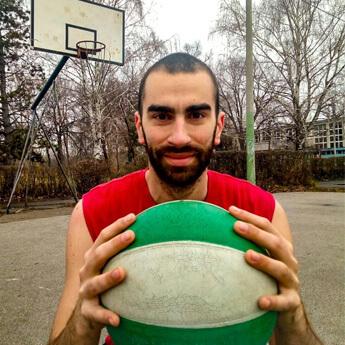Racial Bias in NBA Commentary (Analysis)

After our ground-breaking study that showed racial bias in American football commentary, we decided to expand the research on basketball, using the same methodology.
We analysed 2,085 statements from commentators in 40 NBA games during the 2019/20 NBA season to examine differences in the way commentators talk about players of different skin colour. 300 NBA players of various skin tones were included in the analysis.
Key findings:
- Commentators are:
- 1.78x more likely to talk about athleticism when discussing darker-skinned players.
- 1.37x more likely to talk about intelligence when discussing lighter-skinned players.
- When commentators talk about intelligence:
- 63.41% of praise is directed toward players with lighter skin tone.
- 76.92% of criticism is directed toward players with darker skin tone.
- When commentators talk about athleticism:
- 69.03% of praise is directed toward players with darker skin tone.
- 61.90% of criticism is directed toward players with lighter skin tone.
- When commentators talk about leadership, mentality, and hard work (LMHW):
- 73.9% of criticism is directed towards players with darker skin tone.
- When commentators talk about ability:
- 59.4% of criticism is directed towards players with darker skin tone.
Methodology:
- Selection of Games: Selected a total of 40 NBA games from the 2019/20 season.
- Transcription: Transcribed commentary from each game into a text document.
- Coding (Categorization of Comments): Recorded every adjectival phrase and manually assigned whether the comment was positive (praise) or negative (criticism), a category, and the associated player.
- Analysis and Results: Analysed the ratio of praise and criticism for each category to determine differences in how players of different skin tones are talked about.
- Player Information and Identification of Race: Designated a player as “players with lighter skin tone” or “players with darker skin tone” based on the Fitzpatrick colour scale from the player's headshot pictures.
To view the full methodology please view the methodology section at the bottom of this report.
What does bias look like?
In commentary without bias, the distribution of comments towards players of different skin colours would be similar. For example, players with lighter skin tone should receive the same proportion of comments about their athleticism or their work ethic as players with darker skin tone.
Our analysis shows that this is not the case. Across a large sample, results indicate a bias in the way the media discusses players based on the colour of their skin.
Control category
The control category of “in-game events” was included to support the theory that there would be an even distribution of comments in the absence of bias.
There was less scope for bias in this category given it is “considered probably factual unless additional adjectives characterizing a player were included.” Eastman & Billings (2001).
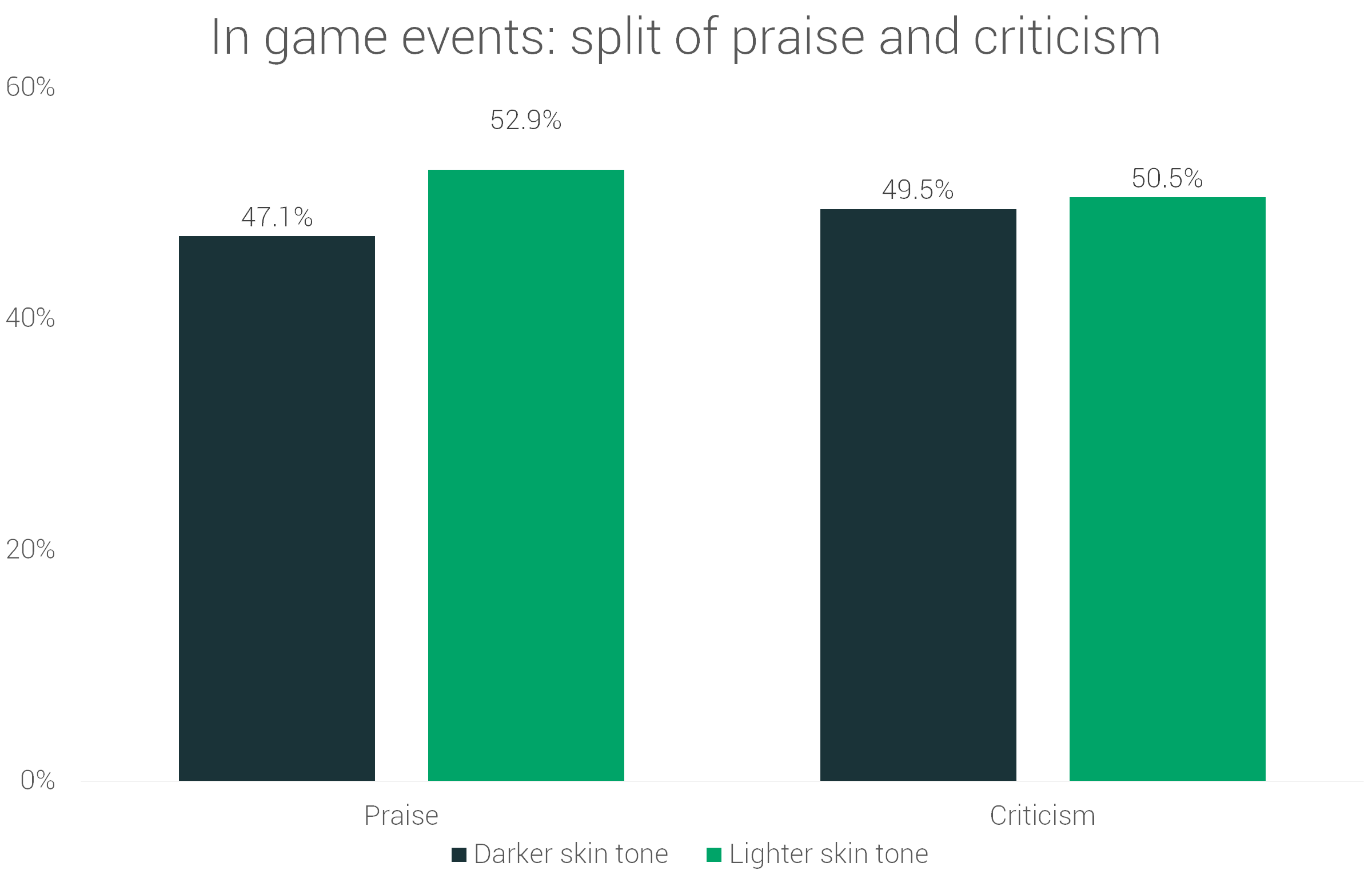
When commentators made purely factual statements (in-game events), both groups received the same proportion of comments and were praised or criticised the same amount. Differences in distribution and split of praise and criticism in other categories indicate racial bias.
Comments like “Nice job by LeBron to take inside.” and “That’s a wasted effort by Shaq Harrison.” are examples of positive and negative in-game events.
Results
Table1: Base numbers
| Darker skin tone | Lighter skin tone (ratio-adjusted) | |||
| Sentiment | Positive | Negative | Positive | Negative |
| Ability | 358 | 38 | 377 | 26 |
| Background | 54 | 6 | 45 | 10 |
| In-game event | 419 | 98 | 470 | 100 |
| Form | 262 | 69 | 245 | 61 |
| Size | 41 | 13 | 45 | 0 |
| Intelligence | 30 | 10 | 52 | 3 |
| Athleticism | 78 | 8 | 35 | 13 |
| Leadership, mentality & hard work (LMHW) | 90 | 17 | 103 | 6 |
What was said about whom and how frequently?
Results of the analysis show a difference in how often commentators talk about certain categories when talking about two groups of players.
Differences emerge in two groups of particular interest - intelligence and athleticism. Commentators refer to the intelligence of lighter skin tone players 1.37x more frequently, while they’re 1.78x more likely to talk about the athleticism of darker skin tone players.
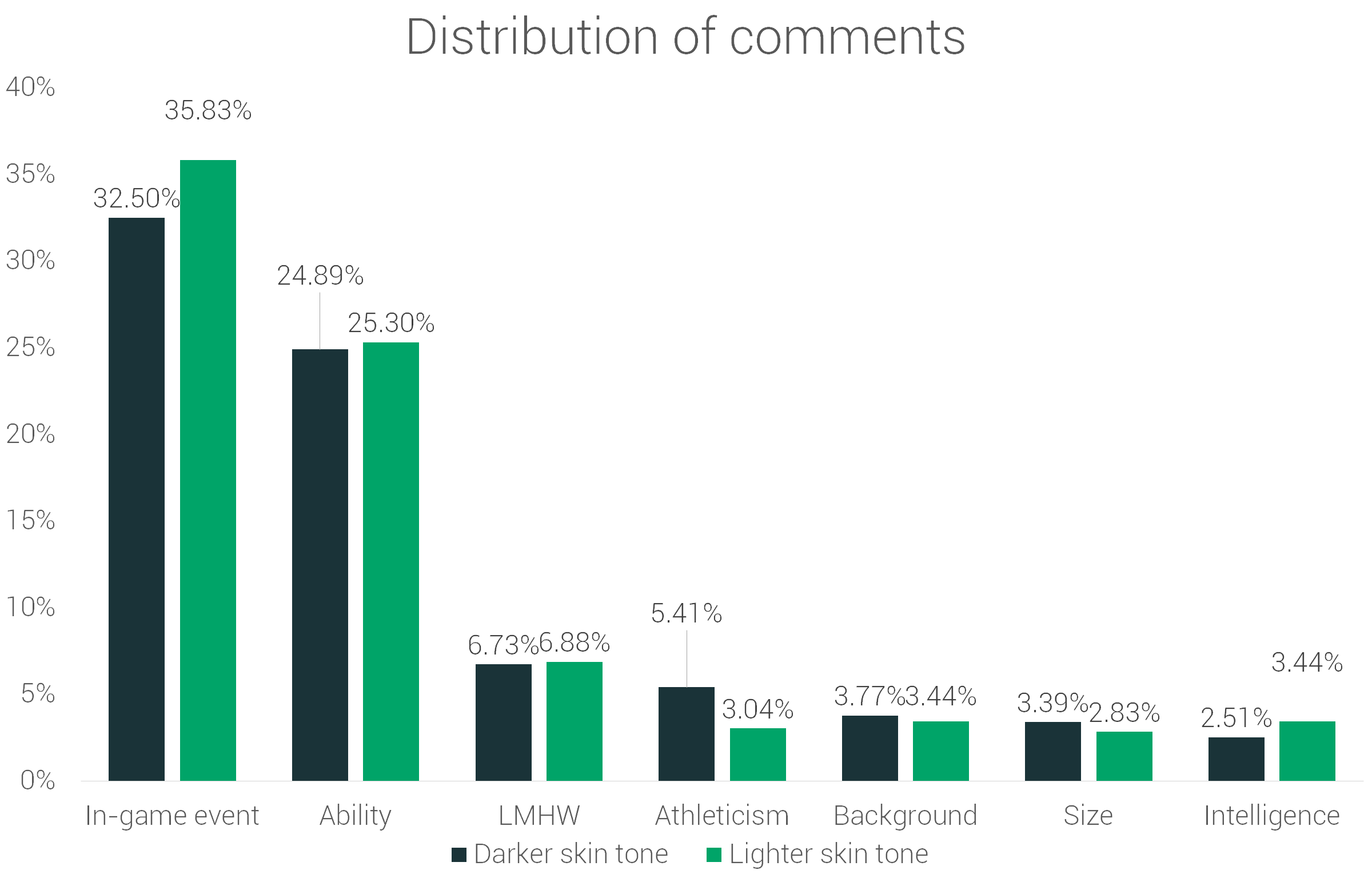
Who was praised? Who was criticised? And for what?
This study comprises 300 unique NBA players, 230 of whom have been classified as “players with darker skin tone” and 70 have been classified as “players with lighter skin tone”.
We used ratio-adjusted numbers for comments about players with lighter skin tone to equal the number of comments about players with darker skin tone, allowing us to do apples-to-apples analysis.

From the chart, we see that commentators praise the intelligence of players with lighter skin tone 63.4% of the time while 76.9% of criticism is directed towards darker skin tone players.
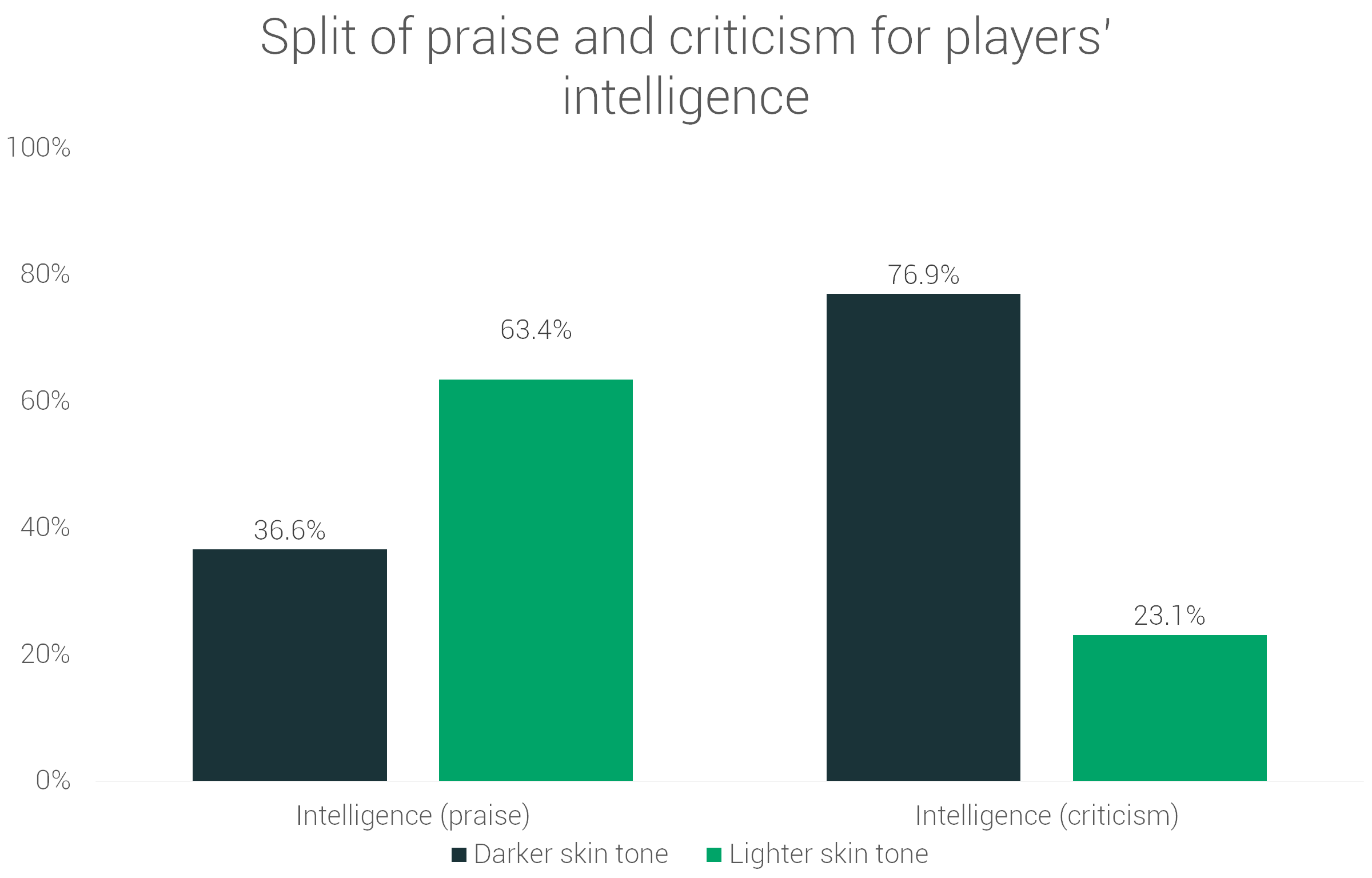
"Doesn’t have all the athleticism in the world but he plays smart.", or “Just bait him into shooting those mid-range.” are examples of comments on intelligence.
Lighter skin tone players are also receiving 53.4% of praise and only 26.1% of criticism about leadership, mentality, and hard work (LMHW).
Examples are comments like “And I tell you what, his work ethic was incredible.” as a positive or “It just does not look like he’s engaged.” as negative.
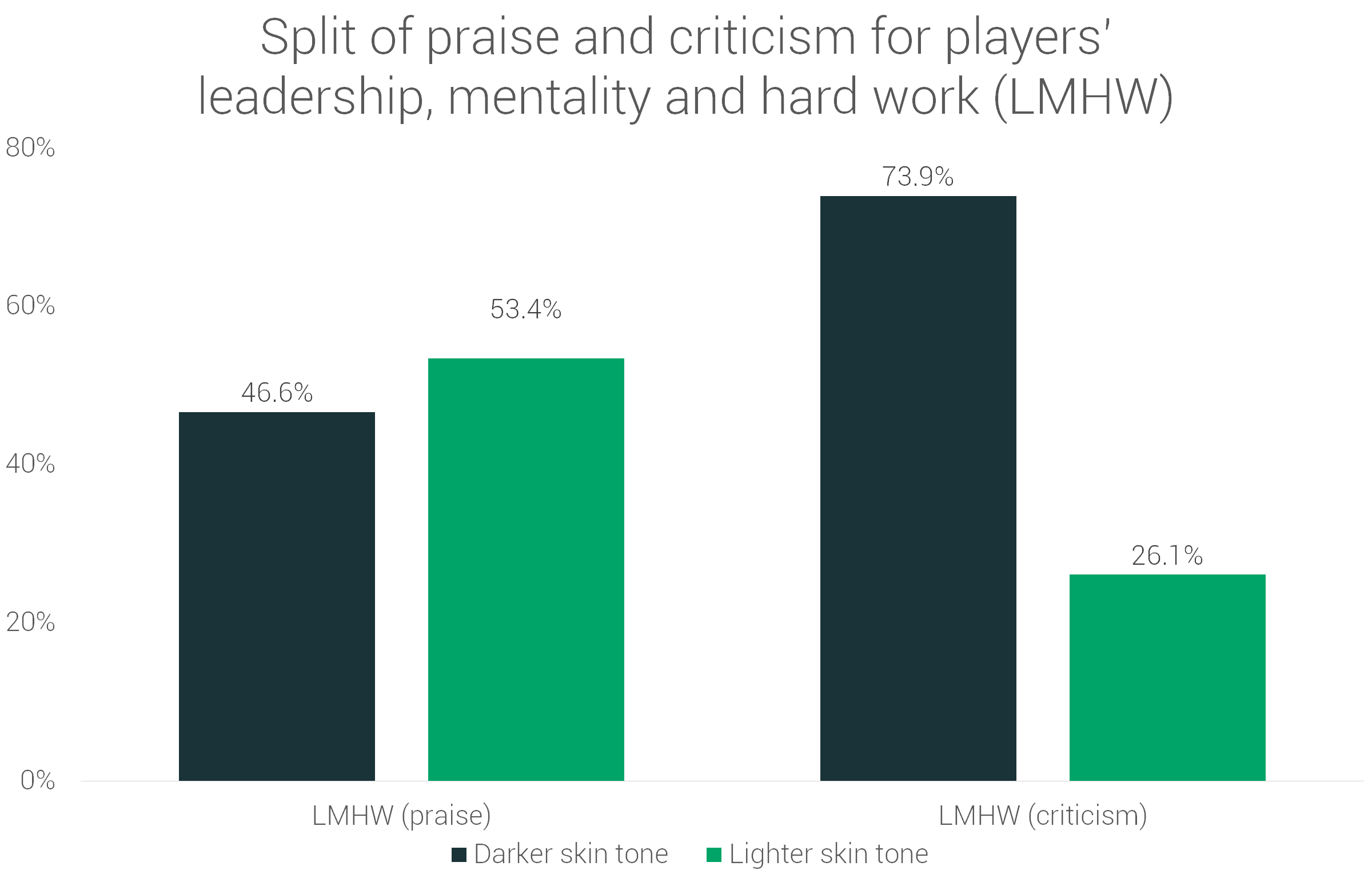
On the other hand, darker skin tone players are praised for their athletic abilities more frequently (69.0% of praise), while lighter skin tone players are criticised more often (61.9% of criticism).
“Well, Morant is lightning quick.” shows how commentators praise darker skin tone players, while “Yeah, we can question his athleticism.” comments negatively about Nikola Jokic’s athletic ability.
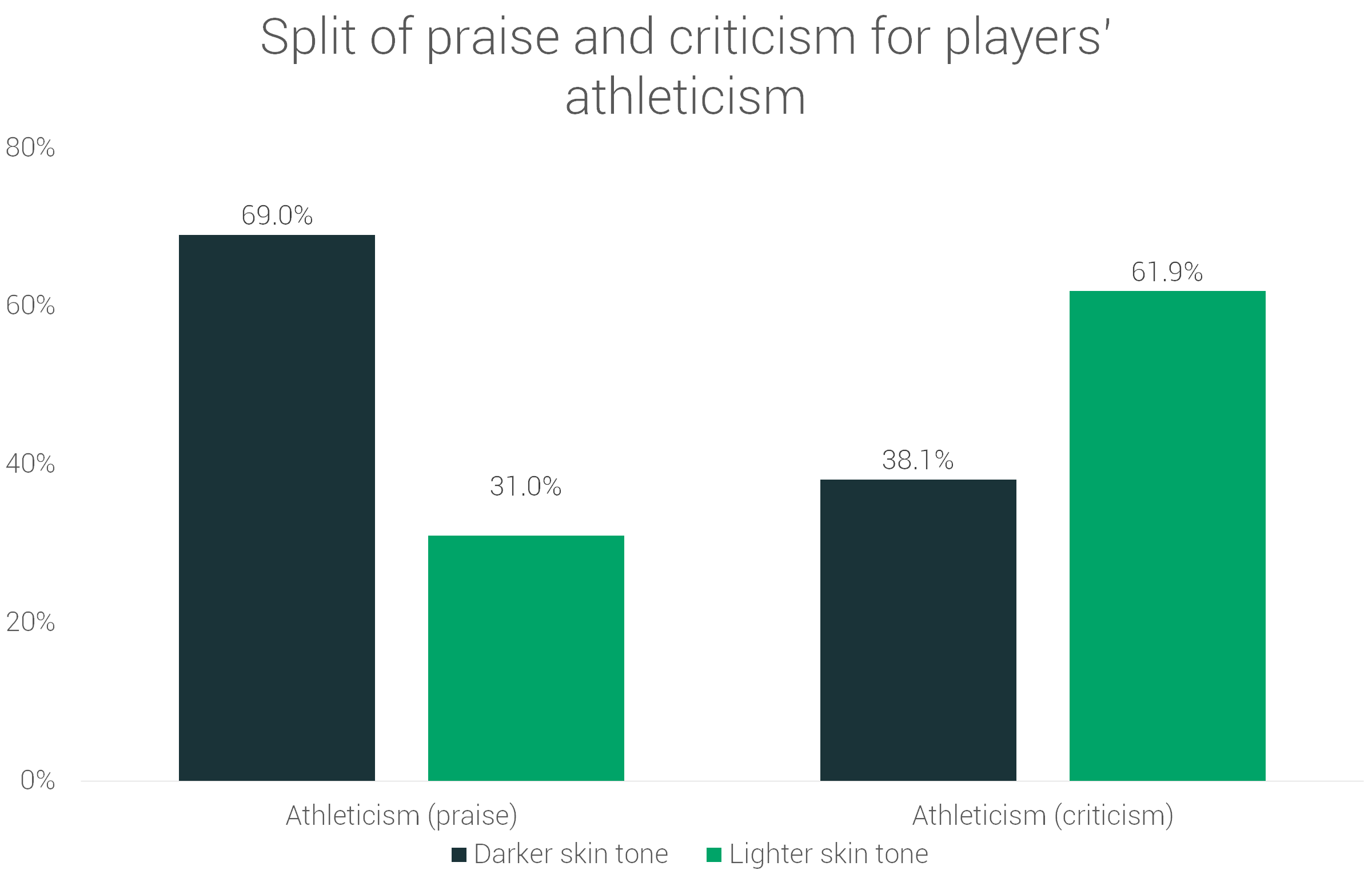
Darker-skinned players also get criticised more for their ability (quality), getting 59.4% of total criticism.
"But Caruso, once again. A defensive demon." shows commentator's praise of Alex Caruso's defensive ability, while "Needs some work on that shot." is an example of a negative comment on Jarrett Culver's shooting ability.
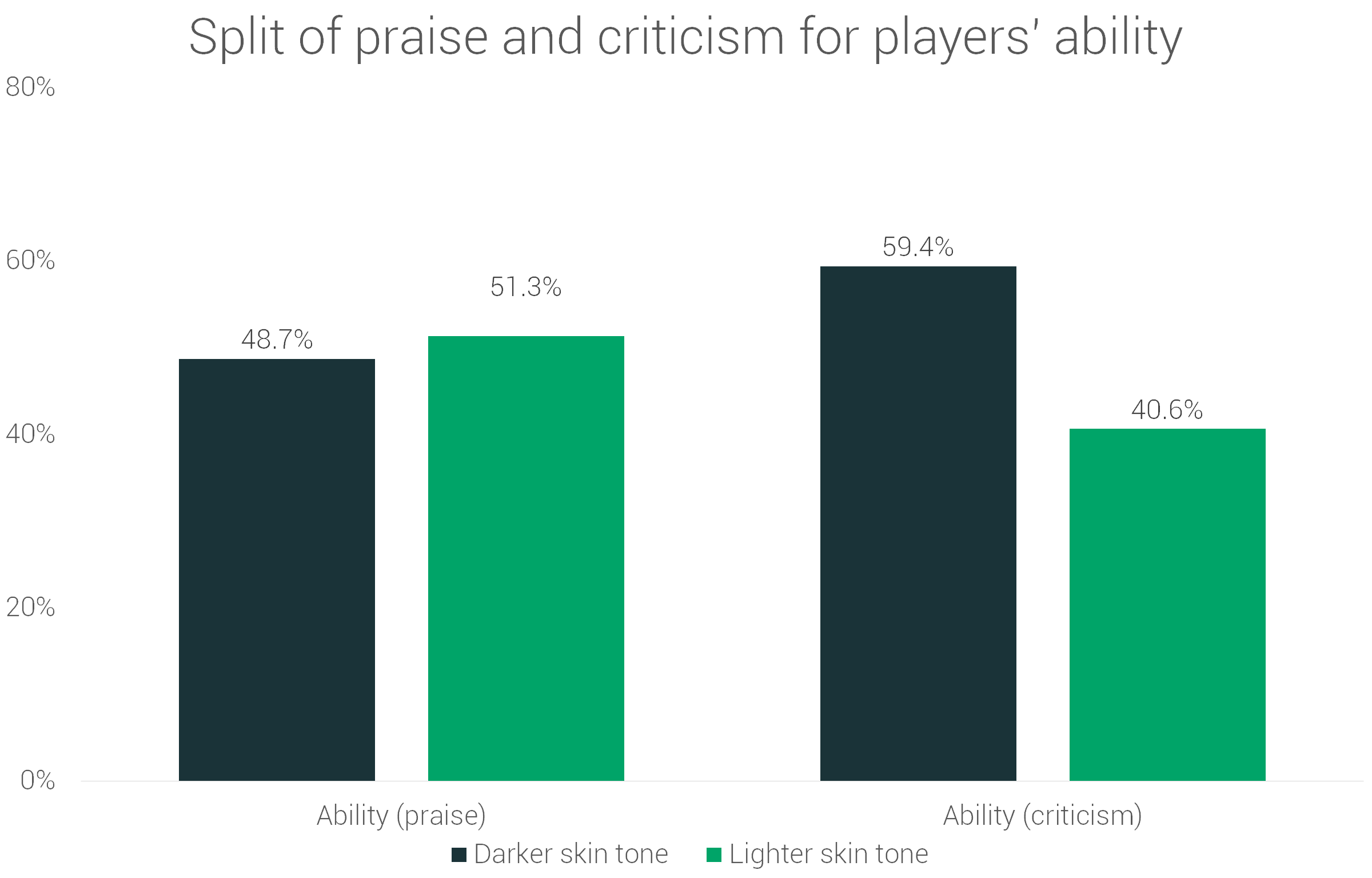
Conclusion
Data presented in this research indicate the existence of commentators’ bias when describing the attributes of NBA players - players of lighter skin tone are perceived as more intelligent and hard-working while comments on physical and athletic dominance are reserved for darker skin tone players.
The perception of athletes based on their skin colour is likely to influence the perception of the basketball public. This is why it’s very important to become aware of unconscious biases and start working toward removing this long-established stereotype.
Full methodology
Selection of games
A total of 40 NBA games were selected at random from the 2019/20 season. Rada’s (1996) method for collecting composite games was used for gathering a sample of games. Segments (1 quarter) from each of the 40 games were taken at random. This was done by creating a list of games to be analysed, then designating a segment to be watched, transcribed, and coded.
For Game 1, 1st quarter would be analysed. For Game 2, the 2nd quarter would be analysed and this would continue for 4 games. Game 5 would return to 1st quarter.
By taking a sample of each game it allows for analysis of a wider variety of teams, players, and commentators, essentially creating a larger sample size from the same hours of coverage. Some teams were involved in multiple games.
The reasons for using live match commentary were best put forward by Rada (1996): “As events transpire in front of them at a machine-gun pace, announcers are caught up in the ‘heat of the battle.’ Having to inform and entertain in this environment, often without the time to choose words carefully, causes announcers to dredge up comments that reflect subconscious beliefs, images, attitudes, and values.”
Transcription
Once the games and segments had been selected, they were downloaded, watched, and transcribed. The outcome of this stage was 40 transcripts (one for each match).
Coding (Categorization of comments)
This research employed many of the categories used in previous researches: Rada & Wulfemeyer (2005) - Color-Coded: Racial Descriptors in Television Coverage of Intercollegiate Sports, and Eastman & Billings (2001) - Biased Voices of Sports: Racial and Gender Stereotyping in College Basketball Announcing.
The coding process involved recording every adjectival descriptor and phrase/ sentence within each of the 40 transcripts. Each phrase was manually assigned by a coder as being positive (praise) or negative (criticism), was assigned a category, and associated with the player in question.
Player information and identification of race
Information on each player’s skin tone was obtained using the Fitzpatrick colour scale. To determine the Skin Tone, we identified skin elements from the player's headshot picture and converted them to RGB value. Using the Euclidean distance, we assigned the player to a category based on the minimum distance between its skin tone RGB value and the Fitzgerald scale RBG threshold value.
By using this, the researchers are not interpreting the race of players and the study is based purely on skin tone rather than ethnicity or a researcher’s interpretation of what race a person is.
A cut-off point must be made to separate the two groups, so all player’s with a skin tone value of 1-3 were classified as “players with lighter skin tone.”, while all players with skin tone value of 4-6 were classified as “players with darker skin tone.”
By focusing on skin tone alone, we are able to show a clear relationship between the colour of a player’s skin, and the analysis that players receive from commentary teams.
Analysis and results
Once coding had been completed and player information had been collected, the end result was 2,085 comments, sorted into 8 categories and associated with 300 unique players.
Given the sample size of 300 players, of which 230 were classified as players with darker skin tone and 70 were classified as players with lighter skin tone, it is reasonable to expect the distribution of comments to be within the margin of error for each category if there was an absence of bias from commentator’s based on the colour of a player’s skin. The fact that there was a significant difference shows bias is present.
Categories
Below is an explanation of the 11 categories included in the study, along with a real example of a comment included in the study for each category:
- In-game event: Factual comments about events occurring within the game. This category has a minimal opinion and is a simple positive or negative comment on events unfolding (e.g. “That looked like a pretty good move there by Leonard.”)
- Size: Any mention of a player’s appearance, mainly related to height and length (e.g. “Justise Winslow, 6’7.” He’s a big, strong guy at 225 lbs.”)
- Athleticism: Any mention of a player’s athletic ability like speed, power, jumping ability. (e.g. “ Well, we know that he is some kind of an athlete. At 6 foot 6, he’s got great hop, excellent speed, and he’s not afraid to take the contact.”)
- Intelligence: Any mention of a player’s in-game intelligence, or a player’s ability to play in various positions or perform multiple tasks for the team (e.g. “Play wasn’t developing but when you’ve got a veteran in Aaron Baynes, he can read it well and it turned into an easy assist for Carter.”)
- Leadership, Mentality, Hard-work (LMHW): Any mention of a player’s leadership ability, will to win or similar mental strength, player’s work ethic or hard work (e.g. “Hwang is chasing that. He Worked so hard to get there.”)
- Form: Praising or criticising a player for how they are playing in the current game or in recent weeks (e.g. “And he averages, uh, in double figures, but this is a terrific performance tonight from him.”)
- Background: Mention of a player’s history or information outside of the current match (e.g. “Bounces time between Salt Lake City and the Jazz and G League team.”)
- Ability: Any mention of a player’s quality, including position-specific abilities or overall quality as a player (e.g. “He's a very good passer.”)
Use of data
All data presented in this research is available for free use, as long as a link to the research is provided as a source reference.
For any questions regarding the research and data presented, feel free to reach out to Dimitrije Curcic, Basketball Research Director, at dimtrije@runrepeat.com
About RunRepeat
RunRepeat is the largest athletic shoe review site in the world. We test basketball shoes on the court and we test them in our in-house lab. Cutting all the shoes in half allows to dig deep when it comes to technologies and features. We make sure that you get the most objective possible data on your favourite model. We also buy all the shoes with our own money.
Check out our reviews of basketball shoes, including all your favourite signature models, from LeBron to MJ. We’ve also prepared in-depth guides that will help you chose the best model for your needs and playstyle.
